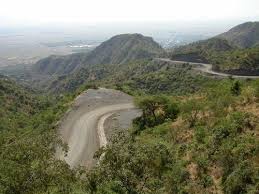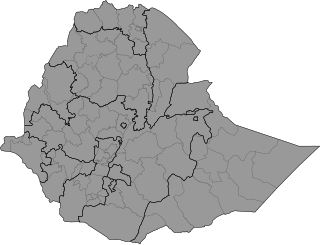The Guassa Community Conservation Area (GCCA) is one of the oldest known common property resource management in Sub-Saharan Africa. It has been the focus of an indigenous natural resource management institution, known as “Qero,” system for over 400 years. [3] The conservation area is located 80 km off the main highway and is home to numerous endemic birds and wildlife species, including the iconic Ethiopian wolf and the Ethiopian Gelada. Its name comes from the high altitude Afro-alpine Festuca grassland, or Guassa grass.
Covering 11,000 hectares, GCCA lies at a latitude of 10° 15′ – 10° 27′ N and longitude of 39° 45′ – 39° 49′ E in the Menz Gera Midir woreda. The Guassa area ranges in altitude from 3,200 to 3,700 meters above sea level. The rugged mountain plateau forms the watershed between the Nile and Awash River systems, thus performing an important hydrological function and catchment area. The eastern edge of the Guassa Area falls away abruptly as cliffs drop into the Great Rift Valley. [4]
The Guassa Area originated as a community-based natural resource management system known as “Qero” over 400 years ago. The Qero system, based on the Atsme Irist tenure system, was organized by two formally elected chiefs from families descended from Gera and Asbo. These chiefs ensure an equitable distribution of resources and enforce the bylaws protecting the common property. Further organization of the user community into parishes gave the Guassa area the status of consecrated land, under the protective patronage of the parish, which reinforced the Qero system with the prestige, power, and authority of another important local level institution. Following the 1974 Ethiopian Revolution, the government nationalized all rural land in the country, and disbanded all local-level land tenure and common property management institutions. This agrarian reform destroyed the Qero system and the Guassa area was turned into an open-access resource, which led to an extreme decline of native flora in the area. [3]
Upon the fall of the Derg regime, local peasant associations (kebeles) organized a land management system, called the Guassa Conservation Council Committee, with a new management system and online bylaws adapted to the current sociopolitical order of the country. The new system consists of nine peasant associations that elect five representatives, each of whom are descendants of Gera and Asbo. Under their care, the area of the GCCA recovered; locals were surprised at how the native species recovered. Five kinds of silvery shrub called “nachillo” (Helichrysum spp.) had always existed in Guassa, but now they seemed to be more widespread than anyone remembered. [3]
Menz or Manz is a former subdivision of Ethiopia, located inside the boundaries of the modern Semien Shewa Zone of the Amhara Region. William Cornwallis Harris described Menz as lying "westward" of Gedem but between that former province and Marra Biete.

Alamata is a woreda in Tigray Region, Ethiopia. Part of the Debubawi Zone, Alamata is bordered on the south and west by the Amhara Region, on the northwest by Ofla, and on the northeast by Raya Azebo. Towns in Alamata include Waja. The city of Alamata is a separate entity and is surrounded by Alamata woreda.

Bugna is a woreda in Amhara Region, Ethiopia. It is named after the former district. Located in the northwest corner of the Semien Wollo Zone, Bugna is bordered on the south by Meket, on the west by the Debub Gondar Zone, on the north by the Wag Hemra Zone, and on the east by the Lasta woreda. The main town is Ayne. The Lasta woreda, where Lalibela is, was split off from Bugna.
Fogera is a woreda in Amhara Region, Ethiopia. Fogera is part of the Debub Gondar Zone. The district is bordered on the south by Dera, on the west by Lake Tana on the north by the Reb which separates it from Kemekem, on the northeast by Ebenat, and on the east by Farta.
Moretna Jeru is one of the woredas in the Amhara Region of Ethiopia. It is named in part after the historic district of Shewa, Moret, which lay between the Jamma River and the district of Shewa Meda. Part of the Semien Shewa Zone, Moretna Jeru is bordered on the south by Siyadebrina Wayu, on the south west by Ensaro, on the northwest by Merhabiete, on the northeast by Menz Keya Gebreal, and on the east by Basona Werana. The administrative center of this woreda is Enewari; other towns in Moretna Jeru include Jihur.
Gishe also spelled as Geshe is a woreda in Amhara Region, Ethiopia. Located at the eastern edge of the Ethiopian highlands in the Semien Shewa Zone, Gishe is bordered on the south by the Menz Gera Midir, on the west and north by the Debub Wollo Zone, and on the east by Antsokiyana Gemza; the Wanchet River defines its western boundary.
Antsokiyana Gemza is a wereda in the Amhara Region of Ethiopia. This district is partly named for one of the districts of Shewa, Antsokia. Part of the North Shewa Zone, Antsokiyana Gemza is bordered on the south by Efratana Gidim, on the southwest by Menz Gera Midir, on the west by Gishe, and on the north and east by the Oromia Zone. The administrative center is Mekoy; other towns in Antsokiyana Gemza include Majete.
Efratana Gidim is a woreda in Amhara Region, Ethiopia. It is named after two historic districts that were part of the former autonomous kingdom of Shewa, Efrata and Gedem. Part of the Semien Shewa Zone, Efratana Gidim is bordered on the south by Kewet, on the southwest by Menz Mam Midir, on the west by Menz Gera Midir, on the north by Antsokiyana Gemza, and on the east by the Oromia Zone. The administrative center of this woreda is Ataye (Effeson); other towns in Efratana Gidim include Jewha and Karakore.
Kewet is a woreda in Amhara Region, Ethiopia. Part of the Semien Shewa Zone, Kewet is bordered on the southwest by Termaber, on the northwest by Menz Mam Midir, on the north by Efratana Gidim, and on the east by Afar Region. The major town in Kewet is Shewa Robit.
Gera Midirna Keya Gebriel was one of the 105 woredas in the Amhara Region of Ethiopia. It is partly named after the northern district of the former province of Menz, Gera Meder. Located at the eastern edge of the Ethiopian highlands in the Semien Shewa Zone, Gera Midira Keya Gebriel was bordered on the south by Mam Midrina Lalo Midir, on the southwest by the Jamma River which separated it from Moretna Jiru, on the northwest by the Qechene River which separates it from the Debub Wollo Zone, on the north by Gishe, and on the east by the Oromia Zone. The administrative center of this woreda was Mehal Meda; other towns include Zemero. It was divided for Menz Gera Midir and Menz Keya Gebreal woredas.
Mam Midrina Lalo Midir was one of the 105 woredas in the Amhara Region of Ethiopia. It was named in part after the central and southern districts of the former province of Menz, Mama Meder and Lalo Meder. Located at the eastern edge of the Ethiopian highlands in the Semien Shewa Zone, Mam Midrina Lalo Midir was bordered on the south by Termaber, on the west and north by Gera Midirna Keya Gebriel, on the northeast by Efratana Gidim, and on the east by Kewet. The administrative center of this woreda was Molale; other towns in Mam Midrina Lalo Midir include Midwegere. Mam Midrina Lalo Midir was divided for Menz Mam Midir and Menz Lalo Midir woredas.
Termaber is a woreda in Amhara Region, Ethiopia. It includes a homonymous mountain pass and road tunnel. Located at the eastern edge of the Ethiopian Highlands in the Semien Shewa Zone, Termaber is bordered on the south by Ankober, on the southwest by Basona Werana, on the west by Mojana Wadera, on the northwest by Menz Mam Midir, on the northeast by Kewet, and on the southeast by the Afar Region. Towns in this woreda include Debre Sina and Doqaqit.
Gindabarat is one of the woredas in the Oromia Region of Ethiopia. The district is marginal within the central-highlands of Ethiopia, being isolated geographically by lowland gorges and rivers which physically separate it from all but one neighboring district, due to a poor road network. Part of the West Shewa Zone, Gindabarat is bordered on the south by Jeldu, on the southwest by Ambo, on the west by the Guder River which separates it from the Horo Guduru Welega Zone, on the north by the Abay River which separates it from the Amhara Region, on the east by the Muger River which separates it from the North Shewa Zone, and on the southeast by Meta Robi. The major town in Gindabarat is Kachise. Abuna Gindabarat woreda was separated from Gindabarat.
Gera is one of the woredas in the Oromia Region of Ethiopia. It is named after the former Kingdom of Gera, whose territory was approximately the same as the modern woreda. Part of the Jimma Zone, Gera is bordered on the south by the Gojeb River which separates it from the Southern Nations, Nationalities and Peoples Region, on the northwest by Sigmo, on the north by Setema, on the northeast by Gomma, and on the east by Seka Chekorsa. The administrative center of this woreda is Chira; other towns in Gera include Cheriko and Dusta.
The title Aleqa is a honorific title used in the Ethiopian Orthodox Tewahedo Church. It is used as the title of a chief priest of a major church, the head of a monastery, as well as being an honorific for a highly educated member of the church, especially in the case of dabtaras.

Districts of Ethiopia, also called woredas, are the third level of the administrative divisions of Ethiopia – after zones and the regional states.
Menz Keya Gebreal is one of the woredas in the Amhara Region of Ethiopia. Located in the Semien Shewa Zone, Menz Keya Gebreal is bordered on the southeast by Menz Lalo Midir, on the southwest by the Jamma River which separated it from Moretna Jiru, on the west by Merhabiete, on the northwest by the Qechene River which separates it from the Debub Wollo Zone, and on the northeast by Menz Gera Midir. The administrative center of this woreda is Zemero. Menz Keya Gebreal was part of the former Gera Midirna Keya Gebriel woreda.
Menz Lalo Midir is one of the woredas in the Amhara Region of Ethiopia. It is named after the district of the former province of Menz, Lalo Meder. Located in the Semien Shewa Zone, Menz Lalo Midir is bordered on the southeast by Menz Mam Midir, on the west by Menz Keya Gebreal, and on the north by Menz Gera Midir. Menz Lalo Midir was part of former Mam Midrina Lalo Midir woreda.
The Guassa Community Conservation Area (GCCA) is a protected area in central Ethiopia. It is one of the oldest known common property resource management in Sub-Saharan Africa. It has been the focus of an indigenous natural resource management institution, known as “Qero,” system for over 400 years It is located 80 km off the main highway, and is home to numerous endemic birds and wildlife species, including the iconic Ethiopian wolf and the Ethiopian gelada. The high altitude Afro-alpine Festuca grassland, or ‘Guassa” grass gives the area its name.
Mehal Meda is a town in Ethiopia situated in the Semien Shewa Zone of the Amhara Region. It has a geographical coordinates of 10° 18' 0" North, 39° 40' 0" East, with an altitude of 3132 m above sea level. The town is located 150 km north of Debre Berhan and 224 mi northeast of the capital Addis Ababa.



